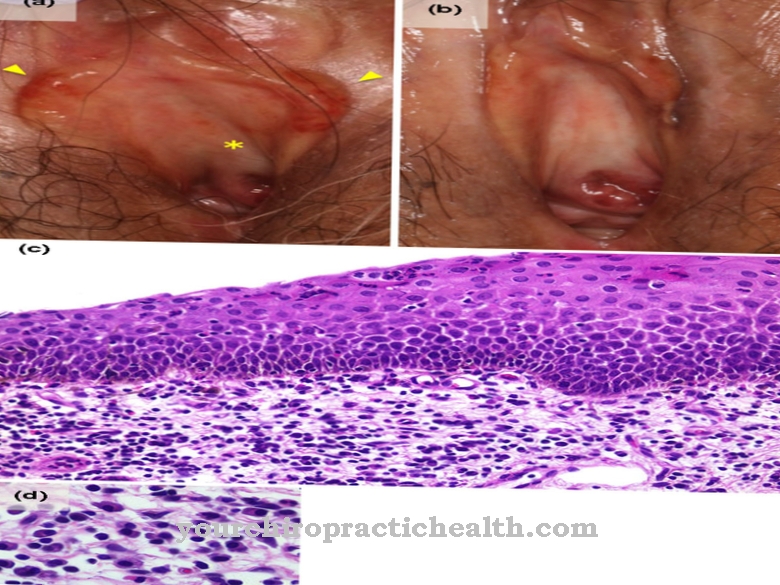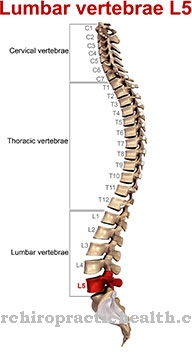A Pigment disorder can affect people of any age and also manifests itself in different forms and forms. For example, the entire body can be affected by the disease or just individual parts of the body. Some forms can be prevented, while other types of pigmentation disorder can be treated but not prevented.
What is a pigment disorder?

© Andrii - stock.adobe.com
A Pigment disorder is when too much or too little melanin is produced, so that the actual color of the skin changes. Normally, the melanocytes ensure that the melanin is formed and the skin takes on a slightly brownish color.
In addition, the color pigments keep UV rays out so that they cannot penetrate deep into the skin. With a pigment disorder, on the other hand, there is a change in skin color on individual parts of the body or on the whole body. Basically, the pigment disorder can be divided into two types: the melanin excess and the melanin deficiency.
The most common form, hypermelanosis, is manifested by excessive coloring of the skin, while hypomelanosis has a reduced melanin content and thus the skin is less colored. In extreme cases, the lack of melanin can lead to complete depigmentation, as no melanin is produced at all.
causes
Depending on the type of Pigment disorder the causes can also be different. Hereditary factors often play a major role and, for example, favor albinism or freckles.
But certain drugs or cosmetic items can also be a trigger. Women in particular are often prone to pigmentation disorders due to hormonal changes, such as when taking the pill or during pregnancy.
In addition, prolonged exposure to cold or heat can impair the formation of color pigments. Triggers that have a stimulating effect on melanin production, such as UV rays or inflammation, should also not be underestimated.
Typical symptoms & signs
- Deficiency or excess of melanin
- Freckles
- Lens spot
Diagnosis & course
The suspicion of one Pigment disorder should of course be checked by a dermatologist. He will first look at the discoloration of the skin, as this can be a very clear indication.
A biopsy from one of the discolored areas of the skin can provide additional certainty. Questioning family members can also be helpful in making a diagnosis if the problem is a hereditary pigment disorder.
Depending on the cause, the course of the disorder varies, but in most cases the disease is harmless and does not cause long-term damage. Lighter forms can resolve on their own in the course of life, while a hereditary pigment disorder often lasts for a lifetime.
Complications
As a rule, a pigment disorder does not lead to particular complications or other serious health problems. The life expectancy of the patient is also not negatively affected, so that those affected can lead an ordinary life. However, a pigment disorder can have a negative impact on the psyche, so that the patients suffer from a reduced self-esteem or possibly from inferiority complexes.
Depression and other psychological upsets can also arise from this and thus have a very negative effect on the quality of life of the person concerned. Furthermore, the pigment disorder can lead to skin cancer more easily, so that those affected are dependent on regular examinations by the dermatologist. With early diagnosis and treatment, however, no particular complications or complaints arise.
In children, the pigment disorder may cause bullying or teasing from those around them. Treatment of the pigment disorder is usually not necessary. These disturbances can possibly be compensated for by cosmetic applications, but this is not always possible. The aesthetic complaints of a pigment disorder can also be masked by various care products, so that the person concerned feels comfortable with their skin.
When should you go to the doctor?
A pigment disorder does not necessarily have to be treated by a doctor. A doctor's visit is necessary if pigment spots or other skin changes are accompanied by other symptoms. Itching or reddening of the skin can indicate a serious skin disorder. If you feel unwell or have hormonal problems, this can indicate skin cancer. A visit to your family doctor or a dermatologist is recommended. Even if psychological complaints such as inferiority complexes or social anxiety occur as a result of the unusual skin spots, specialist medical help is necessary.
Those affected should contact their family doctor or a therapist. The further diagnosis is made by the dermatologist, who can determine the cause and initiate suitable countermeasures. People who already suffer from skin complaints or have a sensitive skin type should have pigment disorders clarified by a doctor quickly. If the typical measures are ineffective, the doctor must be informed.
Depending on the cause and effect of the pigment disorders, the internist or a psychologist can also be called in. In most cases, pigment disorders are unproblematic and do not need to be treated by a doctor. Injuries to the skin or a badly healing sunburn are warning signs that require rapid medical clarification. It is best for those affected to talk to their family doctor if the pigment spots do not go away on their own after a few days.
Treatment & Therapy
Treatment from a medical point of view is only necessary in the rarest of cases, as a rule it is Pigment disorder harmless and has no negative effects on the body. For many sufferers, however, the disease is a major problem for cosmetic reasons.
It is not uncommon for large areas of skin discoloration in particular to be perceived as emotionally stressful, so that different measures can be considered depending on the cause. The basic requirement is that the person concerned protects his skin and does not expose it to intense sunlight. In addition, cosmetics such as camouflage (make-up and make-up) are mainly used in the treatment to cover pigment spots on the face and neck area.
Other parts of the body can be treated with self-tanners or lighteners so that the color changes of the rest of the skin adapt. However, bleach should only be used in consultation with the attending physician in order to avoid possible side effects.
Anyone who suffers from a melanin deficiency can also achieve great success with radiation. Over a longer period of time, an attempt is made in this way to restore the formation of the color pigments, so that the pigment disturbance is reduced.
You can find your medication here
➔ Medicines for pale skinOutlook & forecast
The term "pigment disorder" encompasses various disorders of skin pigmentation. The cause and course of the various skin pigmentation disorders must therefore be considered individually. A generalizing prognosis is not possible.
In the case of pigment disorders such as albinism, the prognosis is negative because the entire skin is affected. This pigment disorder is hereditary and cannot be revised. Age-related pigment disorders can only be revised cosmetically. That worsens the prognosis. Often times, freckles fade in the cold season. However, they reproduce again under the influence of the sun.
In the case of the pigment disorder Vitiligo, also known as white spot disease, in contrast to the aforementioned, a progressive loss of pigment is observed in places. Over the years the spots expand in quantity and size. Spontaneous repigmentation occurs extremely rarely. Drug repigmentation has not yet been possible. Therefore the prognosis is negative.
Pigment disorders can either increase or decrease skin pigmentation. The loss of pigment leads to whitish skin. This stands out clearly from the normally tinted skin. The increase in pigment leads to brownish spots on the skin, as is often found in older people. In and of themselves, pigment disorders of the skin have no disease value. They are disorders that affect skin pigmentation. Pigment disorders can, however, severely stress those affected emotionally if they spread over a larger area. Better sun protection is usually necessary on depigmented skin.
prevention
Whether one Pigment disorder can be prevented, of course, depends on the causes. In any case, frequent visits to the solarium and direct sunlight should be avoided. However, hereditary or hormonal factors cannot be counteracted, so that at most an improvement in the pigmentation disorder can be achieved through appropriate measures.
Aftercare
Follow-up care refers to serious illnesses. It occurs regularly in cancer, which can return after a while. A pigment disorder, on the other hand, is not a life-threatening disease. As a rule, it is harmless and turns out to be a cosmetic problem.
When treatment takes place, it is usually outside the area for which the family doctor is responsible. The patient can hide the stains with cosmetics. In drugstores and beauty salons, he receives sufficient information. If drugs have been identified as the cause of a pigmentation disorder, they can be expected to subside after they are discontinued. In this case, too, there is no medical follow-up.
However, it may take several months for the skin to regenerate. In contrast, pigment disorders that lead to psychological stress are in need of treatment. Those affected then avoid social contacts, which leads to depression. Doctors usually opt for radiation that can last for several months.
The dermatologist will inform you about the number of treatment appointments. Follow-up care also aims to prevent a disease from recurring. In the case of a pigment disorder, the patient is solely responsible for this. As part of the initial therapy, he is informed that he must avoid strong sunlight.
You can do that yourself
People with a pigment disorder often suffer from an optical flaw. Although there are no physical impairments or complaints, a pigment disorder can lead to emotional as well as psychological stress. It is therefore often felt to be helpful when the person concerned gets help and support from people they trust to stabilize the psyche. Conversations with friends, relatives or psychotherapists can bring new perspectives or insights into the person concerned. An exchange in internet forums or self-help groups can contribute to the development of well-being and give new impulses in daily dealing with the pigment disorder.
By wearing clothes that help cover up the abnormalities on the skin, those affected can help themselves in everyday life. Accessories or fashionable clothing accessories can distract from the pigment disorder. Many of those affected perceive this as a relief. In the case of freckles or other unwanted skin changes on the face, it is possible to cover them up with the help of cosmetic products.
Despite the possibilities, it is important to strengthen your own self-confidence in dealing with the pigment disorder in everyday life. In the case of a melanin deficiency, creams that contain enzyme extracts from the milk flora or the right diet can stimulate melanin formation. The consumption of gooseberries and liquorice root has a stimulating effect on the organism and can be used by those affected.


.jpg)










.jpg)

.jpg)
.jpg)











.jpg)